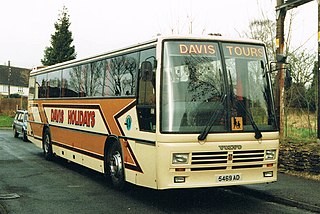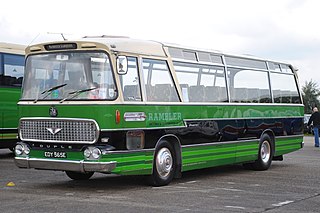 | |
 | |
| Founded | 1908 |
|---|---|
| Ceased operation | 1989 |
| Headquarters | Chilwell |
| Service area | Nottinghamshire |
| Service type | Bus operator |
Barton Transport [1] was a bus company that operated in Nottinghamshire from 1908 until 1989.
 | |
 | |
| Founded | 1908 |
|---|---|
| Ceased operation | 1989 |
| Headquarters | Chilwell |
| Service area | Nottinghamshire |
| Service type | Bus operator |
Barton Transport [1] was a bus company that operated in Nottinghamshire from 1908 until 1989.

In October 1908, Thomas Henry Barton used a Durham Churchill charabanc to start the company's first service, between Long Eaton and the Nottingham Goose Fair. (Many years later, in 1953, Barton built a replica of its original Durham Churchill vehicle, using a Daimler chassis dating from 1911.)
Barton had already had experience of operating a motorised bus, in Mablethorpe, some nine years earlier.
During World War I, the fleet was used to transport workers to and from the National Shell Filling Factory, Chilwell. Also during the War, Barton pioneered the use of town gas as fuel, converting the whole fleet to run on it. The gas was stored in a large "bag" on the roof of the bus, and the company also manufactured these bags for sale to other operators.
The 1920s saw fierce competition in the British bus industry. Barton imported Lancia chassis from Italy, which were lengthened and fitted with a patented tag-axle by Barton. [2] The vehicles were known as "Bartons Gliders" and their speed and smooth riding provided a competitive advantage.
Barton scored a first by operating the first diesel-engined passenger-carrying road vehicle, a Lancia, in 1930. Barton had earlier been an engineer at Hornsbys where he had worked on the early development of "oil engines" (he always refused to use the term "diesel"). Leylands were purchased from the mid-1930s and made up a large part of the fleet by the beginning of World War II. Starting in 1939, a fleet of Leyland Titan TD5, TD7 and rebodied TD1 double-deckers with stylish, front-entrance, lowbridge bodywork by Duple and Willowbrook was purchased, which appeared very modern by the standards of the day. [2]
Although Barton gained a reputation for having a varied fleet of vehicles during the 1950s and 1960s, from 1946-9 the vast majority of new chassis were from Leyland, and virtually all coachwork was from Duple. The Duple A type coach was chosen for PS1 Single deckers, some featuring a more compact front-design allowing up to 39 seats in the then maximum overall length of 27 ft 6in. The 40 postwar double deckers on PD1 or PD1A had an updated version of the forward entrance lowbridge body with more brightwork and power-operation for the entry door. [2] Barton was a prolific rebuilder of buses — between 1950 and 1955, fifty-eight BTS1 "Viewmaster" single-deck coaches were rebuilt from Leyland Titan, Tiger, and Lion chassis; between 1959 and 1961, seven BTD2 full-fronted double-deckers were created from the chassis of a Leyland Tiger and six Titans; and between 1969 and 1971, eleven AEC Reliance chassis were rebuilt as Barton BTS2 and fitted with new Plaxton Panorama Elite bodywork. [3]

Many new and secondhand buses also joined the fleet, and Barton kept up its modern double-deck image with Northern Counties bodied AEC Regents, which had wrap-around windscreens on both decks. Also built to the same style was a unique vehicle, no. 861, which had lowbridge bodywork on a lowheight Dennis Loline chassis, and was the lowest ever roofed British double-decker. It was specially designed to pass under an ultra low railway bridge at Sawley Junction, now Long Eaton, station. [4]
During the 1950s, Barton had over 280 vehicles and 1,000 employees. Numerous smaller companies were purchased, especially in the 1960s, including Hall Brothers of South Shields on Tyneside (1967), and Robin Hood Coaches of Nottingham (1963), whose emblem was retained and applied to the whole fleet.
From the early 1970s, Barton began to standardise on new coaches for all of its purchases. Most were either Leyland Leopards or Bedford Y series, and the large majority had Plaxton Elite Express or Supreme Express bodywork, built with a wide doorway and other minor modifications making them eligible for a Government grant towards their purchase. The wide variety of older vehicles was eradicated within a few years. By this time Barton was Britain's largest independent bus operator, and it was very unusual for such a large operator to use coaches on all of its local services, as well as on tours and express work. In 1981 the company joined the British Coachways consortium which competed with National Express on long-distance routes. The consortium was wound up in 1982. [5]
In 1983, Barton bought five Leyland Tigers and five DAF MB200s with Plaxton Paramount bodywork, these being the company's first modern 12m coaches, although not its first 12m vehicles, since Barton had experimented with lengthening a Daimler bus to 40' before World War I. From 1984 until the sale of the fleet in 1989, Barton standardised on the DAF MB with Plaxton Paramount bodywork, a further 26 being purchased.
In 1989, the business was sold to the Wellglade Group and merged with its Trent Buses business to form Trent Barton. [6] [7] [8]
On 1 October 2008, the journey of the first Barton bus, from Long Eaton to Nottingham's Market Square, was recreated to mark the centenary of the company. Buses and coaches from each decade of service travelled along the route, becoming more modern in turn. [9]
Barton also had a road freight haulage operation for a number of years.
From 1929 until 1991, Barton had a 50% shareholding in South Notts Bus Company, based in nearby Gotham. [10]
The Barton company still exists today, having dropped "transport" from its title, it is known as Barton Holdings, mainly involved in property ownership. [1] [11] The Chilwell depot site was the subject of an unsuccessful planning application in 2007, which would have seen the sprawling site redeveloped into housing and retail.

Barton's fleet livery was red, cream and maroon. The fleetname (rendered as BARTON) was placed within a flag motif on the vehicle sides, and, from the 1960s onwards, a detailed picture of Robin Hood was placed alongside following the acquisition by Barton of Robin Hood (Coaches) Limited of Nottingham in late 1961. [12]
Barton operated from many depots and outstations over the years. The largest depot was at the company's headquarters in Chilwell. Others included:
Barton's former depot on Huntingdon Street in Nottingham was Grade II listed in August 2019. The building was opened in 1939, and was constructed in the Moderne architecture style typical of the period. At the time of listing the building was still owned by the Barton family company, who had submitted planning approval for it to be "dismantled with care" and eventually re-erected at their corporate headquarters in Chilwell, to allow redevelopment of the city centre site. [13]

The Dennis Dart is a rear-engined single-decker midibus chassis that was introduced by Dennis Specialist Vehicles of Guildford, England in 1989, replacing the Dennis Domino. Initially built as a high-floor design, In 1996 the low-floor second generation Dennis Dart SLF was launched. In 2001, production of the Dart SLF passed to TransBus International, during which time it was sold as the TransBus Dart SLF; Alexander Dennis took over production in 2004, renaming the product as the Alexander Dennis Dart SLF.

The Northern Counties Motor & Engineering Company was an English builder of bus and coach bodywork based in Wigan.

Duple Coachbuilders was a coach and bus bodybuilder in England from 1919 until 1989.

The Leyland Leopard was a mid-engined single-decker bus and single-decker coach chassis manufactured by Leyland between 1959 and 1982.
A lowbridge double-deck bus is a double-decker bus that has an asymmetric interior layout, enabling the overall height of the vehicle to be reduced compared to that of a conventional double-decker bus. The upper deck gangway is offset to one side of the vehicle, normally the offside, and is sunken into the lower deck passenger saloon. Low railway bridges and overpasses are the main reason that a reduced height is desired.

South Notts Bus Company was a bus company operating in Nottinghamshire from 1926 until 1991 when sold to Nottingham City Transport who continue to use the brand name today.

The Daimler Fleetline is a rear-engined double-decker bus chassis which was built between 1960 and 1983.

The Dennis Loline was a low-height double-decker bus manufactured by Dennis between 1958 and 1966.
Invictaway was an express commuter coach service from Kent to London in the 1980s and 1990s, and was also a holding company for the emerging Arriva group. As a legal entity of the Maidstone & District bus company, after the cessation of the Invictaway coach services, the Invictaway company legal lettering persisted as a holding company for the Arriva subsidiaries in Kent, and some London operations. This company was based in the Armstrong Road M&D depot in Maidstone. This ceased in 1997 when the operations were reconstituted as Arriva London and Arriva Southern Counties.
Gibson's of Moffat was a bus and coach operator in Dumfries & Galloway, Scotland. It is no longer in business.

The Leyland Tiger Cub was a lightweight underfloor-engined chassis manufactured by Leyland between 1952 and 1970.

The Daimler Freeline was an underfloor-engined bus chassis built by Daimler between 1951 and 1964. It was a very poor seller in the UK market for an underfloor-engined bus and coach chassis, but became a substantial export success.

The Leyland Tiger was a heavyweight half-cab single-decker bus and coach chassis built by Leyland Motors between 1927 and 1968, except the period of World War II.
H. V. Burlingham was a British coachbuilding business based in Blackpool, Lancashire from 1928 until 1960 when they were taken over by London-based rivals Duple Motor Bodies. Duple initially renamed Burlingham as Duple (Northern) but in 1969 they closed their Hendon factory and concentrated production in Blackpool. Duple coach bodies were built in the former Burlingham premises until Duple itself was liquidated in 1989.

The Leyland Royal Tiger Worldmaster, sometimes simply known as the Leyland Worldmaster, was a mid-underfloor-engined single-decker bus or single-decker coach chassis manufactured by Leyland between 1954 and 1979.

The Bristol LH was a single-decker bus chassis built by Bristol Commercial Vehicles (BCV) in Bristol, England. Nearly 2,000 were built between 1967 and 1982 in a variety of sizes and body types, including some as goods vehicles.
The Wellglade Group (WG), is a transport group operating bus and tram services in the English Midlands.

The Duple Calypso was a design of semi-integral coach built by Duple between 1983 and 1984 using running gear from the Bova Europa.

The Duple 300 Series were a range of bus and coach bodywork built by Duple between 1985 and 1989. The range comprised the 3,000 mm high Duple 300 service bus, the 3,200 mm high Duple 320 coach, and the taller 3,400 mm high Duple 340 coach. The 320 and 340 coaches were announced at the Bus and Coach Show at Earls Court in September 1985 as replacements for the previous Laser and Caribbean. Deliveries of these models commenced in 1986, whilst the 300 bus was launched in 1987 as a replacement for the Dominant Bus. After Duple closed down the designs were sold to Plaxton and a small number of additional 320 bodies were built as the Plaxton 321.

The Duple Viceroy was a type of coach bodywork built by Duple between 1966 and 1972. It was initially launched on lightweight front-engined chassis, but it was latterly built on mid-engined and heavyweight chassis as well. A variant of the Viceroy was the Duple Viceroy Express, which had a bus-type entrance door making it suitable for stage carriage work.